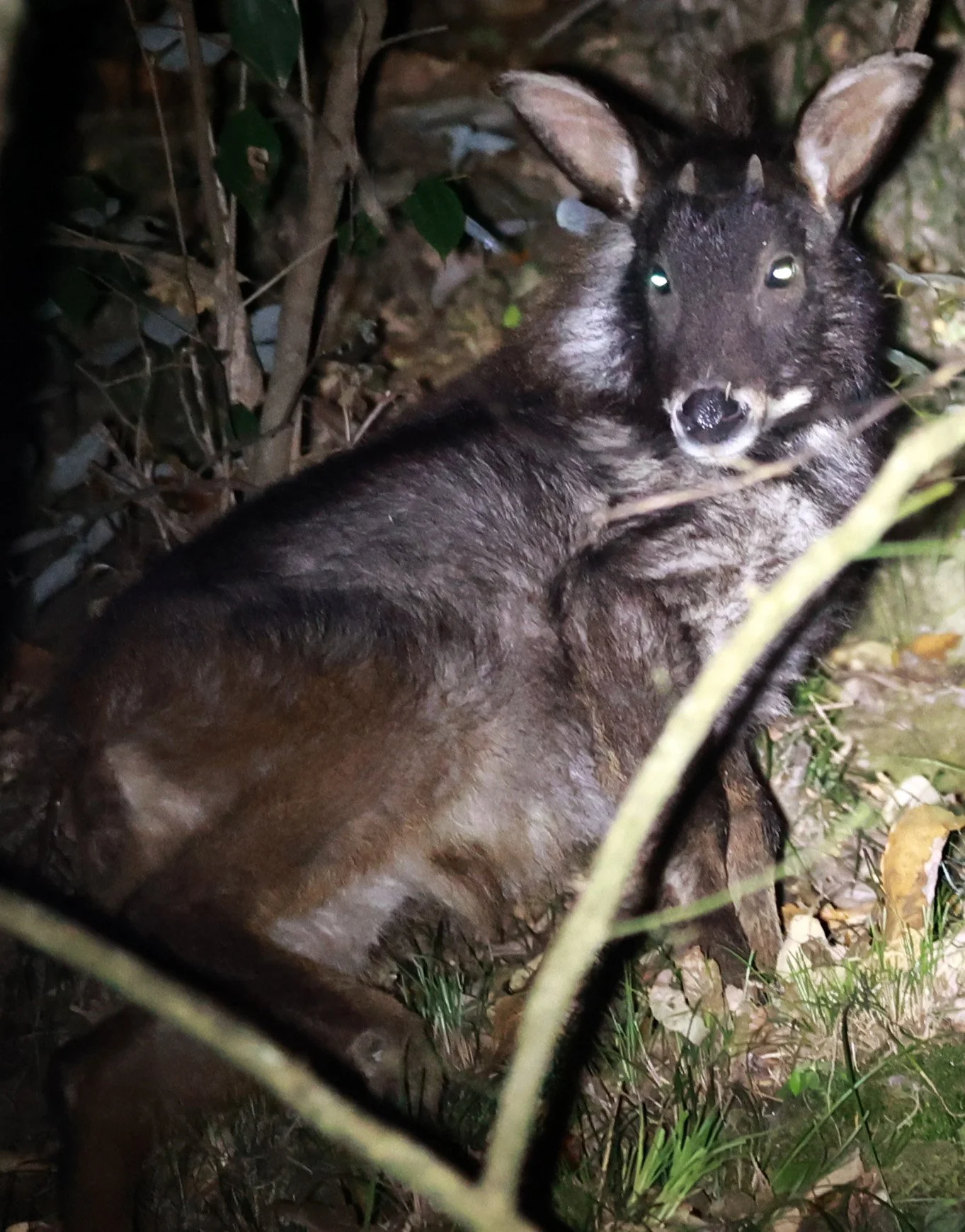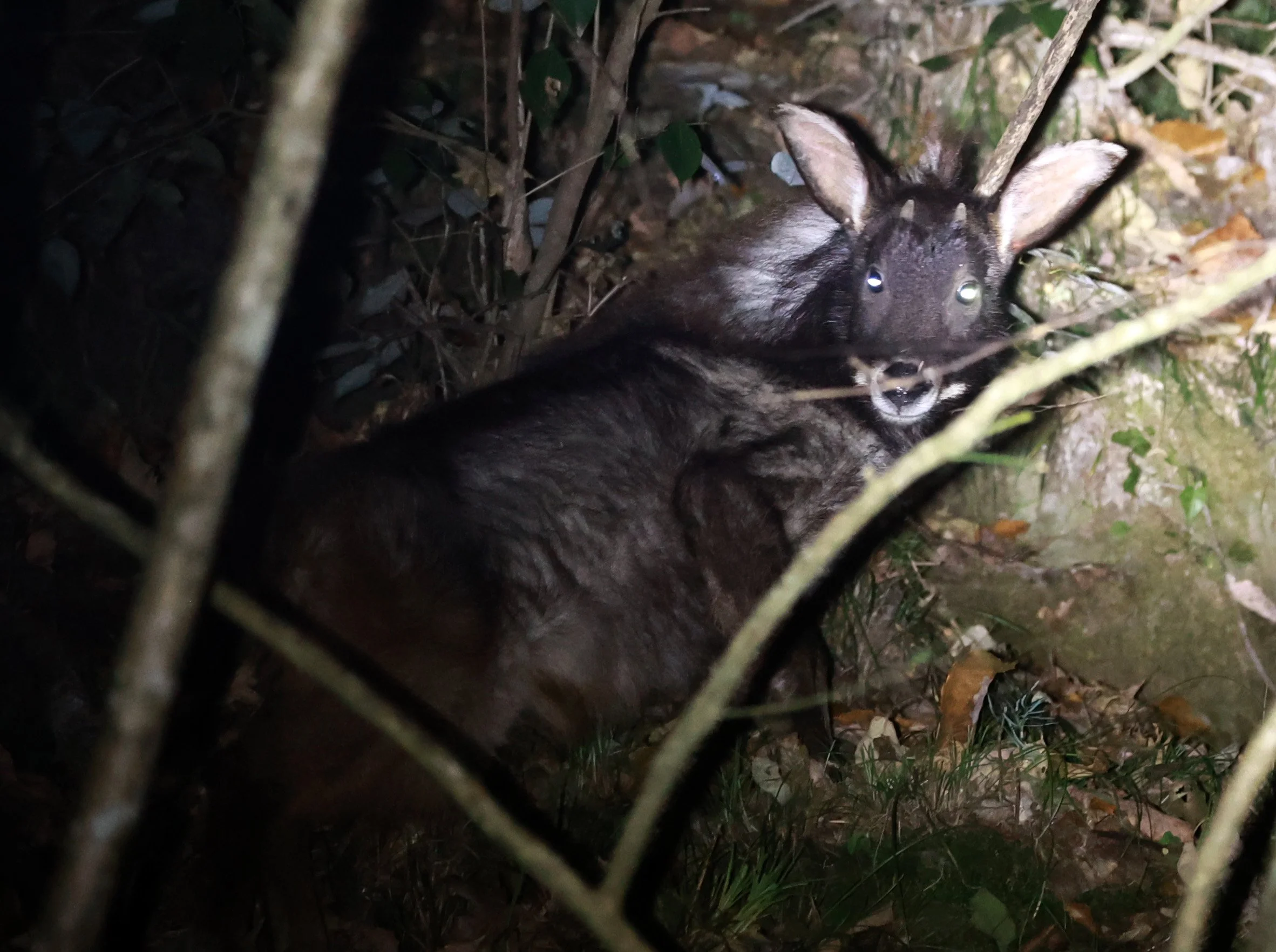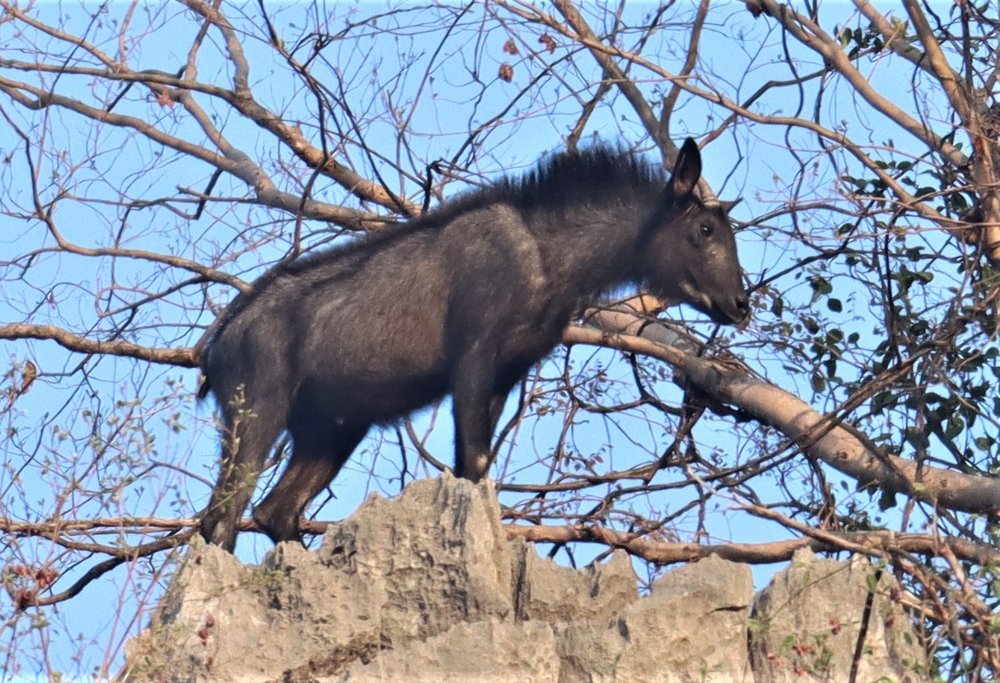Chinese Serow (Capricornis milneedwardsi milneedwardsii)
Distribution map of the six species of Serow. Currently disputed, this map shows the accepted distribution of the Chinese or White-maned Serow.
The Chinese Serow (Capricornis milneedwardsi milneedwardsii) appears to be a controversial species in the literature with the American Society of Mammalogists currently considering it to be conspecific with the Indochinese Serow (Capricornis sumatrensis). With numerous field observations of my own however, I have decided to create two pages for this species acknowledging the quite obvious morphological differences between the Chinese and Indochinese Serow species.
Typical“ Chinese Serow: Because of animals like this the species was also called “White-maned Serow“. But not in all regions of the distribution range specimens show manes with this kind of long, silvery hair. It has been also suggested that mane characteristics are a function of age.
Previously classified as a subspecies of C. sumatraensis; monotypic. Other authors have devided the species into China Serow (C. milneedwardsi milneedwardsii) and Indochinese Serow (C. milneedwardsi maritimus).
The taxonomic validity of this species, and its relationship to other species in the genus Capricornis needs to be assessed.
The Chinese Serow is slightly larger than the Sumatran Serow. The Sumatran Serow is overall black, the Red Serow red. Himalayan Serows feature the typical trichromatism – black, red, white. The Indochinese Serow is smaller and has a less striking mane.
The Chinese Serow (Capricornis milneedwardsi milneedwardsii), virtually endemic to China is widely distributed through much of central and south-eastern China. The general distribution range may be taken to include all the area of the Southwest China Region from southern Gansu southward through Sichuan and most of Yunnan, and beyond into Myanmar. The species is replaced in parts of northern Myanmar by the Red Serow (Capricornis rubidus), and probably by the Himalayan Thar (C. thar) in parts of western Myanmar. Populations in southeast China (south of the Yangtze river) are small and isolated, and their general distribution range falls within regions with relatively dense human populations which are well-exploited economic areas. Although no population estimates have been made in this area, numbers are believed to be decreasing and its distribution range is gradually being reduced.
Chinese Serow (Capricornis milneedwardsi milneedwardsii) clearly showing the reddish flanks and grizzed whitish mane indicative of this species in Tangjiahe National Nature Reserve, Sichuan China
The distribution boundary between Chinese Serow (C. milneedwardsi) and Indochinese Serow (C. maritimus or C. sumatrensis) is drawn by some authors close to the political boundary between China and Myanmar, Laos and Vietnam. It is uncertain, but likely, that the distribution ranges of C. milneedwardsii, C. maritimus and C. rubidus meet or overlap in Myanmar, Shan States (upper Salween River). However, Rabinowitz (1998) reported that the Red Serow and the Indochinese Serow distribution ranges do not overlap in Myanmar.
General description
length / head-body: a large animal – 140-180 cm (1); 140-165 cm (3). (The Indochinese Serow is described as being smaller.)
shoulder height: 100 to 112 cm (1); 85-94 cm
weight: 85-140 kg (1); 100-160 kg
The body in the Chinese Serow is covered with coarse, long, lank, hairs and little underwool; generally black, grading to reddish on flanks, rump and tail. Much white showing through from the white hair bases. In the western parts of China the pelage colour is generally darker, superfically appearing deep black, although the bases of the hairs are grayish to whitish.
Dolan (1963) blamed age for some of the differences between the described taxa. He noted that young animals can be black and adults, “strong brown“. The Chinese Serow is paler, even light . (In the Indochinese Serow: darkish, often black) In Chinese Serow (as well as in Indochinese Serow) a median stripe of all black hairs extends down the back to the basal half of the tail.
Chinese Serow from Tangijahe: Probably more characteristic than the mane are the rusty legs – showing no white at the lower end.
In the Chinese Serow the typical mane is thick, long, shaggy, mainly silvery. In animals from Zhejiang Province (Southeast China) hairs from the center mane are whithish with brown tip.
From the knee down Chinese Serow exhibit a rust colour which extends on the hind legs upwards along the edge of the buttocks. Sometimes there is a sharp demarcation at the knee. (4) (In the Indochinese Serow the red of the legs seems – at least sometimes – not to be as obvious.)
Habitat
The Chinese Serow inhabits rugged steep hills and rocky places, especially limestone regions up to 4,500 m asl (e.g. Duckworth et al. 1999; Lekagul and McNeely 1988, Smith and Xie 2008). However, the species is also routinely recorded (by camera-trapping) in hill and mountain forest areas with gentler terrain (R. Timmins pers. comm. 2008), and does occur in flatter areas marginally (Will Duckworth pers. comm. 2006).
It is likely to tolerate moderately degraded habitat well, due to its presence in natural karst scrubland, though it is unlikely to be present in heavily disturbed areas such as agricultural land (W. Duckworth pers. comm. 2006), and has been documented amidst secondary forests and swidden in at least one landscape mosaics of such habitats and ‘primary’ forest (W. G. Robichaud in litt. to R. Timmins pers. comm. 2008). In parts of China it winters in the forest belt, ascending into alpine cliffs in summer (Yao, 1990).
In 1962, a die-off caused by an unknown epizootic was reported in the Tangjiahe area, Qingchuan County, Sichuan.
Primarily a browserf they feed on a wide range of leaves and shoots, and visits saltlicks. Older males are considered solitary, but detailed studies are lacking.
The Chinese Serow is listed as “Near Threatened“ on the IUCN Red List. Populations of the White-maned Serow are not monitored. Therefore status and population numbers are unknown. It is considered to be decreasing in numbers but probably stable in some isolated areas. Greatest threats are habitat loss and degradations through deforestation and land clearing because of agricultural expansion, piecemeal clearance for firewood and timber resulting in fragmented populations. Illegal commercial hunting is also a factor. Meat, body parts used for medicinal purposes, and even live animals have a significant economic value for local people. The inaccessibility of much of the species preferred habitats is likely to be the serow’s main defence against eradication in most sites where it still occurs. In China it is in class II list of protected species.
This serow exists in many protected areas in the following provinces – Sichuan: Baihe, Fentongzhai, Jiuzhaiguo, Labahe, Mabian Dafengdin, Meigu Dafengdin, Tangjiahe, Tiebu, Wanglag, Wolong and Xiaozhaiziguo; in Shaanxi: Tabaishan, Foping (Wu et al., 1986) and Takin Reserve; in Gansu: Baishuijiang and Tou’ersantan; in Yunnan: Fenshuilin, Gaoligongshan, Tongbiguan, Xishuanbangnan and Yulonghabaxueshan (Lijiang and Zhongdian); in Fujian: Daiyunshan and Wuyishan; in Zhejiang: Fengyangshan and Jiulongshan; in Jiangxi: Jiulianshan and Wuyishan; in Guangxi: Congzuo Xiling, Huaping, Qianjiadong, Shouchen and Yindinshan; in Guizhou: Fenginshan; in Guangdung: Chebaling.
Indochinese Serow (Capricornis sumatrensis) from Thailand showing clear differences between this species and the Chinese Serow.
Conservation measures proposed for China:
1) Reclassify serow as Class I in the national wildlife protection list.
2) Ban hunting and 3) the State Commercial System should be prohibited from purchasing products of this animal.
3) Conduct basic population surveys to determine distributions and numbers for development of conservation actions.
4) Undertake studies of ecology, population and management problems of this serow as part of the conservation management program for the giant panda.
References:
(1) Damm, Gerhard R. and Franco, Nicolás, 2014: The CIC Caprinae Atlas of the World – CIC International Council for Game and Wildlife Conservation, Budakeszi, Hungary in cooperation with Rowland Ward Publications RSA (Pty) Ltd., Johannesburg, South Africa.
(2) Duckworth, J.W., Steinmetz, R. & Pattanavibool, A. 2008. Capricornis milneedwardsii. The IUCN Red List of Threatened Species 2008: e.T3814A10101852. http://dx.doi.org/10.2305/IUCN.UK.2008.RLTS.T3814A10101852.en. Downloaded on 20 May 2017.
(3) Wilson, D.E. and Mittermeier, R.A. [eds], 2011: Handbook of the Mammals of the World. Vol. 2. Hoofed Mammals. Lynx Edicions, Barcelona.
(4) Groves, Colin and Grubb, Peter, 2011: Ungulate Taxonomy. The John Hopkins University Press.
(5) Castelló, José R., 2016: Bovids of the World – Antelopes, Gazelles, Cattle, Goats, Sheep, and Relatives. Princton University Press.
The above information was adapted from:
Chinese Serow (Capricornis milneedwardsi milneedwardsii) – Ralfs' Wildlife and Wild Places
Chinese Serow (Capricornis milneedwardsi milneedwardsii) Tangjiahe National Nature Reserve, Sichuan China
Comparison of Chinese & Indochinese Serows. Currently the same species (Capricornis sumatraensis), there are distinct morphological differences between the two populations worthy of note. See the below images:
Chinese Serow (Capricornis milneedwardsi milneedwardsii) Tangjiahe National Nature Reserve, Sichuan China - Note the differences with the Thai or Indochinese Serow to the right. Color of hind legs, white/grey coloration, white mane, etc
Chinese Serow (Capricornis milneedwardsi maritimus) Pak Chong, Khao Yai, Thailand - compare with the Chinese Serow to the left
















































